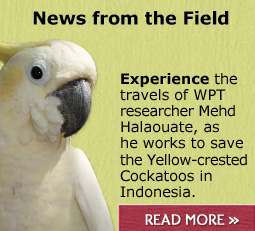|
Status: Critically Endangered.
Wild population: Fewer than 1,000 individuals.
Where found:
C.s. sulphurea: Sulawesi and Pasoso
C.s. parvula: Across Nusa Tenggara, with largest population on Komodo/Rinca Islands; also Timor Leste
C.s. abbotti: Restricted to Masakambing Island, in Java Sea
C.s. citrinocristata: Restricted to Sumba in Lesser Sunda Islands
History:
The Yellow-crested Cockatoo was formerly common throughout Nusa Tenggara, Sulawesi and other islands and the Masalembu Islands in Indonesia. Now it is confined to a few islands: in the past 40 years it has suffered massive population declines estimated at more than 80%, leading to a classification by IUCN as critically endangered. The nominate race and all related subspecies have been reduced
to small remnant populations of only a few hundred birds scattered throughout Indonesia. Three subspecies, sulphurea, abbotti, and citrinocristata, are the most imperiled. The subspecies parvula is a bit more robust. The total population of all subspecies is likely fewer than 1,000 birds.
Threats:
- Unsustainable exploitation for the wild bird trade
- Overharvesting of trees and conversion of primary forest for agricultural use reducing food and nest availability
- Persecution as a crop pest
- Possibility of introduced disease
- Competition from other birds for nest sites in large trees
- Unpredictable weather, leading to low breeding in either too high or too low rainfall years
|
|
|
|
Conservation actions:
Long identifed by the World Parrot Trust as a species of concern, early efforts focused on gaining international protection by encouraging CITES parties to list the bird as an Appendix I species. Recent efforts focused on a one-year collaboration in 2011/12 with the Indonesian Parrot Project (IPP) and Konservasi Kakatua Indonesia (KKI), to assess the current population status of the cockatoo on the islands of Sumba, Pasoro, Komodo, Rinca, Nusa Kode, Gili Motang, and Masakambing. Initial results of this survey indicated that the species is in much greater peril than previously thought.
Future actions:
Efforts may include activities such as:
- Assessing the current number of birds in the wild
- Gathering data about habitat use
and daily activities
- Examining the existing threats to nesting cockatoos and potential solutions
- Researching causes of poor reproductive success
- Aiding the species' reproduction through the introduction of nest predator deterrents to avoid nest losses
- Where needed, supplemental feeding and medical care of chicks in wild nests
- Provision of artificial nests to increase overall availability
- Mapping of nesting trees (old and new)
- Educating local people to understand the uniqueness of these birds, and encouraging participation in actions to save them
Supporting organizations and partners
Current and past collaborators include: the Wildlife Conservation Society, Indonesian Parrot Project, Konservasi Kakatua Indonesia, Natural Encounters Conservation Fund, Paradise Park, Disney Worldwide Conservation Foundation, Ocean Park Conservation Foundation.
|


